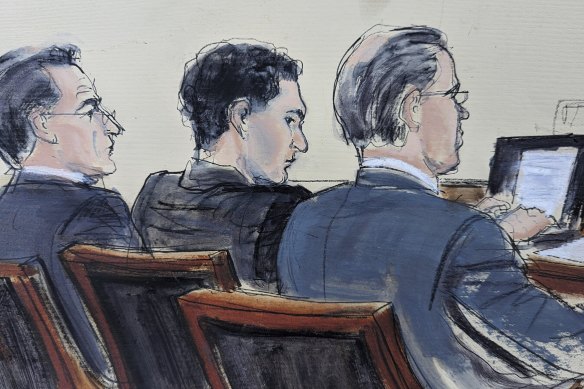This was published 1 year ago
Opinion
Liar or unlucky? Making sense of the Sam Bankman-Fried crypto trial
Elizabeth Knight
Business columnistIt is difficult to pick who will emerge the biggest loser in the Sam Bankman-Fried trial that has captivated the world. If he is found guilty of fraud, he could face the rest of his life staring at four confining walls in striped pyjamas. But the already beaten-up crypto asset class is also in the frame.
Set in a Manhattan courtroom, this is the litigation equivalent of a page turner.
Bankman-Fried stands accused of stealing billions from his customers, but the under-regulated Wild West environment which cryptocurrencies occupy was arguably an enabler.

Sam Bankman-Fried, the founder of bankrupt cryptocurrency exchange FTX, arriving at pre-trial court proceedings in New York in August. Credit: Reuters
And like any page turner, it has lots of juicy details: Bankman-Fried, a young profligate risk-taker, lived the rarefied life of a billionaire – an arguably offensive lifestyle that included ownership of a large exotic real estate portfolio in the Bahamas, and outsized influence in the corridors of US political power and the entertainment industry.
“He had wealth, he had power, he had influence, but all of that was built on lies,” prosecutor Thane Rehn said on the opening day of hearings this week. “He was committing a massive fraud, and taking billions of dollars from thousands of victims.”
In a book recently published by The Big Short writer Michael Lewis, the bestselling author said that at one time Bankman-Fried even explored “the legality of paying Donald Trump himself not to run for president”. Some advisers to Bankman-Fried informed him that Trump’s price was $US5 billion ($7.9 billion), Lewis wrote.
Cryptocurrency is a relatively young asset class that experienced a meteoric rise, capturing the minds of risk-loving investors. It could mint overnight millionaires, or send investors to the wall.
On the spectrum of risk, crypto sat closer to a casino than to government bonds. So not surprisingly, for the most part, it was eschewed by the investing establishment, particularly those managing the trillions of dollars of superannuation and pension funds.
Bankman-Fried became something of a talisman for the industry, and when his crypto trading platform FTX crashed into bankruptcy owing $US3.1 billion to creditors, so did the chances of crypto’s chances of ever being accepted as a legitimate investment.
FTX’s collapse last year was as large and fast as it was noisy.
‘Behind the curtain, Sam Bankman-Fried was not who he appeared to be. He was using his company, FTX, to commit fraud on a massive scale.’
Prosecutor Thane Rehn
The Bankman-Fried trial will remind those arguing that crypto can be a legitimate investment option that the risks attached are considerable, and as supporters they are in the minority.
Rather than a middle-aged, suit-wearing person in an office, the portrait of a crypto investor these days looks like a young person, most often male, who when not trading gimmicky-sounding blockchain assets is playing video games. It is a demographic which rarely baulks at risk.
But it’s worth remembering how crypto as an asset class became difficult to ignore in 2021, with its market value rising to $US3 trillion before it imploded the following year to be worth $US796 billion.
Many of the venture capital funds that joined the crypto craze in 2020 and 2021 were burned, and their current investment in the sector is a shadow of where it was at the peak.
The implosion was the result of a decision by central banks to increase interest rates, making riskier assets far less attractive.

This courtroom sketch shows Samuel Bankman-Fried, centre, flanked by his defence attorneys Christian Everdell, left, and Mark Cohen, right, during the jury selection in his fraud trial.Credit: AP
FTX wasn’t the only or the first crypto company to fall. But its implosion hastened the dominoes falling.
Although crypto has now had several periods of reckoning, it still has a pulse. This year, much of the price volatility has disappeared – which perversely would hamper its appeal to investment thrill seekers.
As for Bankman-Fried, the rollercoaster that started moving a year ago is far from finished.
As Rehn summed it up in the court proceedings, “one year ago, it looked like Sam Bankman-Fried was on top of the world. He ran a huge company called FTX. He lived in a $US30 million apartment in the Bahamas. He jetted around the world on private planes. He hung out with celebrities like Tom Brady and politicians like Bill Clinton. Behind the curtain, Sam Bankman-Fried was not who he appeared to be. He was using his company, FTX, to commit fraud on a massive scale.”
Bankman-Fried’s lawyer Mark Cohen in contrast portrays his client as an unlucky guy with a challenged ability to make good judgement calls.
“Things were happening quickly, very quickly. Sam and others were making hundreds of decisions a day,” Cohen said. “And as a result, some things got overlooked … things an older company would have built out over time.”
The jury has the job of sifting through these arguments, and piecing together what really went down at FTX in the crypto craze.
The Business Briefing newsletter delivers major stories, exclusive coverage and expert opinion. Sign up to get it every weekday morning.